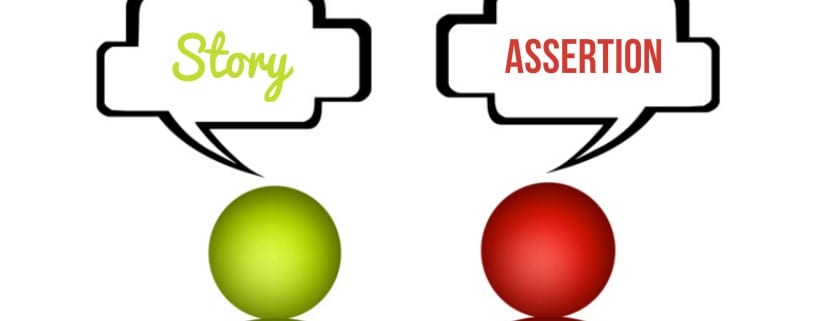If you’re in sales, you know that one of your most important ways to build credibility is through success stories.
However, many success stories are more like success reports. They often consist of lifeless facts that every salesperson in the organization is told to present to every prospect. As such, they are usually presented as boiler plates, with bullet-pointed facts that are more relevant to a general audience than any audience in specific.
Here’s a somewhat tired template that you may be familiar with. 
•State The Problem
i.e. “Life Charities was having a difficult time generating donations”
•State The Solution
i.e. “We showed them how to increase their donations through our car donation program.”
•Show Measurable Results.
i.e Life Charities increased their donations 3-fold in one year.
Oftentimes, the measurable results part is played up more than any other facet of the success story. This happens despite the fact that success is often achieved through a number of factors outside our control. Most audiences know better than to give you 100% credit for the success you are claiming as your own.
Also keep in mind that whenever you tell a success story, people expect it to have a happy ending. We don’t call them success stories because they give us a chance to wax on about our failures. I bring this up not to diminish the importance of results. In fact, don’t. However, if you’ve ever taped a sporting event or watched a movie where you know how it ends, you know that the real interest in any story comes from events leading up to the results, and not just the results themselves. How you stage those events can say more about you and your company than the actual results you’ve achieved.
A story is something that arouses emotion, while engaging, inspiring and motivating its audience. Using the 3-R’s approach to structuring and telling a success story will help you engage your audience far better than the standard problem, solution, and results triumvirate. Using this approach will turn a lifeless, factual success report into something that will involve your audience by helping them imagine a similar success.
The 3-R’s of a powerful sales success story. The three R’s stand for Relate, Rescue, and Resolve. Here’s how to put the 3R’s to work:
RELATE
Success stories are effective to the extent your audience can relate to them. It is critical that you be able to draw parallels between the problem you are describing and a problem or problems that your prospect is experiencing. Do otherwise and your presentation will be an invitation to mentally check out. It is arguably better to have no success story at all than to have one that has nothing to do with your prospect’s situation.
Don’t leave it up to your prospect to find the relevance between the problem you solved and the problem they want solved. Use words like “just like you,” or “similar to what you’re currently experiencing…” For this reason, the “You” word is one of the most important, if not the most important word in your presentation.
Just make sure you’ve done your homework. You’ll gain points by having equipped yourself with facts about your prospect’s current problem, but you could blow-up your entire presentation with a set of wrong facts or worse yet, faulty assumptions.
However you can, don’t make the company you worked with the centerpiece of your story. People relate to people more than they relate to companies. ABC Lugnuts Inc. may have had a problem, but talk more about Mr. Lugnuts, what he was experiencing and how he felt being faced with his problem. Perhaps he was frustrated with what had been tried in the past? Perhaps he was perplexed, confused, or convinced that there was just no workable solution to his problem. Again, RELATE: Any good story conveys emotions its audience can identify with.
Don’t gloss over the problem you were faced with. One of the big reasons stories are more interesting than reports is that stories are comprised of conflicts that need to be overcome. Do what you can to help your prospect feel the pain that your client or customer was experiencing. Beware however. Don’t go overboard. There’s no need for big drama – in fact, avoid it. Your audience does not have the time nor the patience for a sideshow. A question like “Have you ever experienced a 20% drop in sales over the course of a month,?” can suffice. If your prospect answers yes, they know the pain. If they answer no, help them imagine what that pain feels like.
RESCUE
Don’t think that simplifying your solution is always the best route to take. A statement like “All it took was our product to turn things around,” is an overstatement that will lose your audience entirely. Talk about some of the difficulties you experienced before finding the best solution. This is an opportunity to show your prospect how you work as much as it is a way to show them that you can solve problems. You want your audience to hear angles singing in the background when talk when you describe the rescue. Skip through your success story without talking much about the rescue, and the only thing your audience will hear are thoughts wishing you were done.
Use dialogue. Nothing makes a story more interesting than dialogue. One of the reasons for this is that dialogue allows your audience to experience the situation as opposed to being told about it. “And then he said Jim, that just won’t work,” is much more interesting that telling your audience that at first, your client resisted your solution.
If you can, talk about the specific insight or realization you helped your client come to. Bring your audience to the doorstep of your “aha” moment. Help them see how you got there. However, maintain a sense of humility. It’s better to say something like, “after struggling with this a bit, it suddenly dawned on me,” than “the solution was obvious.” If you can, use “We” instead of “I,” by all means, do so.
If possible, show how you made your client a partner in coming up with the solution. Demonstrate that you are collaborative and work with, not for your clients.
Above all else, show how your solution is similar to a solution that your audience would be interested in. Help your audience see themselves sharing the same insight.
RESOLVE
Again, your audience knows that this story is going to have a happy ending. Otherwise you wouldn’t be talking about it. Measurable results are important. But even more important are the changed feelings that were experienced. Go beyond the numbers to explain the long-term effect your solution had on sentiments that were felt, like new optimism or an improved sense of purpose.
If you’re interested in learning more ways to use storytelling as a sales tool, visit Storytelling For Sales Workshops.
Click here to learn more about how to tell your brand story!















